Is it ironic that I am going to begin a post about how I came to organize my kitchen spice shelf with pointers to a product that I did not use for this purpose?
Canning jars—domestic Ball jars or European Weck jars—are one excellent way to store seasonings. I use them all the time for grains, freeze dried food decanted from large #10‡ cans, and leftovers, but they weren’t the best option for my spices.
Before I tell you how I did end up organizing my seasonings, protected from light, yet on an open shelf approximately 35″ x 12″, allow me to share one specific solution others on the internet seem to have missed.
Solution to deli container spice storage: the plastic vs. glass dilemma
Articles like this one from TheKitchn suggest deli containers for space-efficient storage of relatively large quantities of spices for cooking. You can fit any measuring spoon in them, even those big round Tablespoons!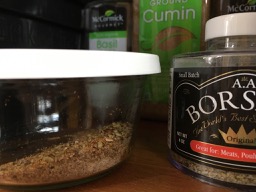
I stumbled upon blog posts where people liked the deli container notion while not wanting to keep sensitive foods in plastic. Plastic, of course, can leach chemicals into foods with unknown health effects, especially in the presence of heat.
Do you ever set your spice jars down next to—or right on top of—the stove?
For those disinclined to worry about chemical exposure from plastics and their effect on human health, I recommend reading Count Down: How Our Modern World Is Threatening Sperm Counts, Altering Male and Female Reproductive Development, and Imperiling the Future of the Human Race by Shanna H. Swan, PhD.
Plastic is also prone to static, an annoyance with expensive dry powders like most spices.
If you want to store your spices in “deli containers,” but you prefer the non-reactive nature of glass to the typical deli dish’s plastic, what you want are 1/5 L Weck Mold Jars in style #740 ($17.25 for a set of six, but shipping is extra and glass is both heavy and fragile.)
The 1/5 L Mold Jar is about the size of a cream cheese or sour cream tub. It’s just shy of two inches high.
The taller, same diameter 1/4 L Weck Mold jar #741 ($18.50 for a set of six) makes another good choice for really serious cooks. If you store even larger quantities of your most used spices, this one is similar in size to a cottage cheese tub. This size is about 2 ¾″ high.
Six #740 jars with six plastic lids and shipping to my zip code would total $34.35† for a cost of $5.73 each as of April 2021.
My family uses both of these sizes of Mold jars to put away our leftovers. This fridge photo shows the 1/5 L Mold jar full of beans stacking neatly atop a plastic deli tub of applesauce; next to that, a 1/4 L Mold jar holds a partial tomato under its glass lid.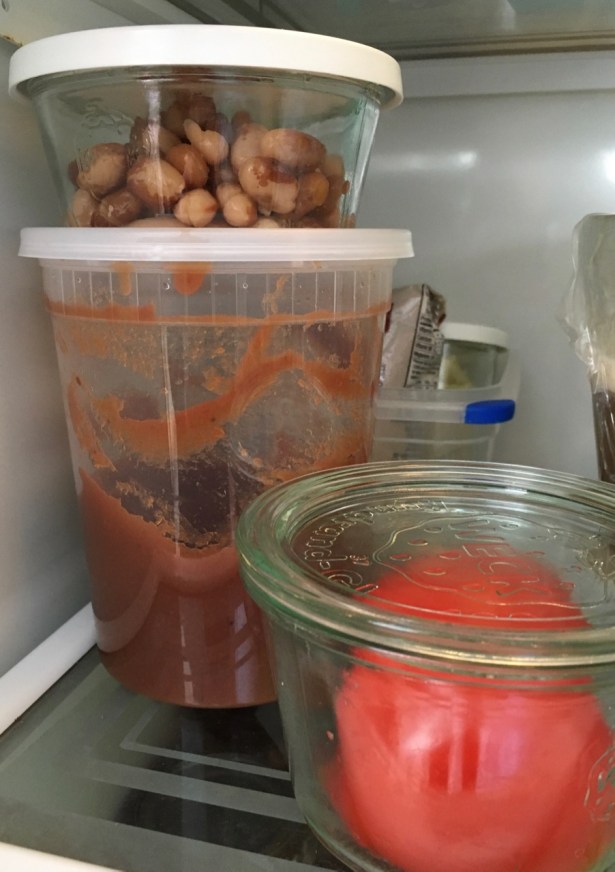 Note that these are European canning jars, so the included lid will be a round of glass that merely sits in place until sealed via heat processing around its separate rubber ring (not ideal for your dry spices!) For that reason, you will also need to purchase a plastic (size Large, 85¢ each), cork (size Large, $1.20 each), or wood (size Large, $3.50 each) lid for each glass container for which you want an air-resistant* seal.
Note that these are European canning jars, so the included lid will be a round of glass that merely sits in place until sealed via heat processing around its separate rubber ring (not ideal for your dry spices!) For that reason, you will also need to purchase a plastic (size Large, 85¢ each), cork (size Large, $1.20 each), or wood (size Large, $3.50 each) lid for each glass container for which you want an air-resistant* seal.
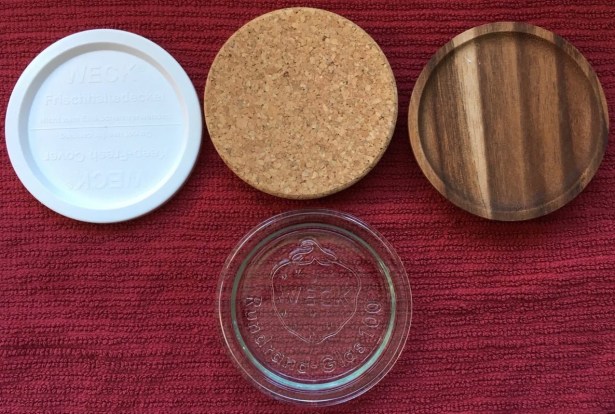
Only the glass and plastic lids are dishwasher safe, but all the glass jars can go in the dishwasher.
It should be noted that even the 3- 7/8″ Large lids sometimes slipped through the top rack grid on my Bosch** machine, and they can warp after too much exposure to the higher heat on the bottom rack. The lid on the far right was warped when it fell to the bottom of my dishwasher.
I love the interchangeable nature of these lids. You can buy Weck jars going all the way up to 2.5 L in size. Americans, that’s a large enough canister for a supermarket bag of sugar. One could store all necessary spices and most other common baking ingredients in attractive, non-reactive, stackable containers where the loss of a single lid doesn’t render any one useless.
If ordering Weck jars for the first time, pay attention that your selections use the same size lid if you share my obsession with owning just a few lids that fit all of your containers.
The Weck “Mold jars” most similar to American plastic deli packaging use lids in size Large, 3 7/8″ ∅. 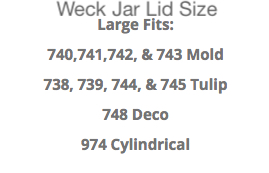
At this point, I own Small and Large opening Weck jars, using both all the time, but I started out with only narrow ones. I was specifically shopping for juice jars sometime around 2004 when I discovered them at a specialty kitchen retailer.
The manufacturer’s US website eventually gave me a much broader selection of shapes and sizes from which to choose.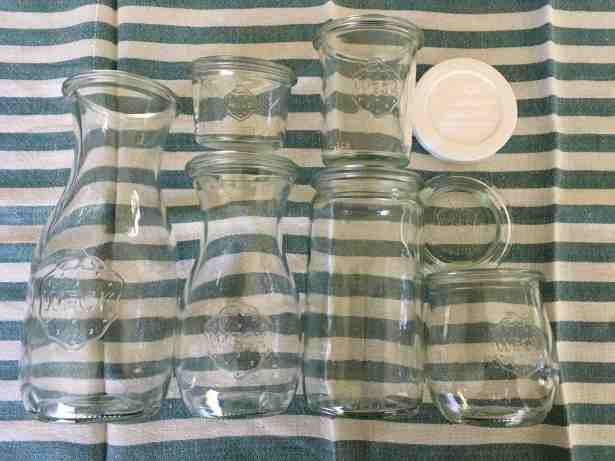
Weck jars are made in Germany. Because they are designed for use in canning, they are thick, sturdy glass, resistant to thermal shock, suitable for either a boiling water bath or storing food in a freezer.
Just not directly from boiling to freezing, please, to avoid shattering; it’s still glass!
My kitchen is warm & bright, bad for spices if nice for people
All of this talk about storing spices in wide, shallow deli containers, yet the Mold jars I already owned weren’t a great choice for my own kitchen needs. We enjoy a bright, sunny, southern exposure, but all that light speeds degradation of herbs and spices.
Clear plastic or glass spice jars should ideally be stored in a cupboard away from light—and heat, whether from the sun or the stove—to maximize each ingredient’s useful shelf life.
I don’t have much available cupboard space available on the side of my kitchen that houses the stove, but I do have room for a shallow, folding bookcase about six feet away from the cooker’s heat. It’s ideally located and doesn’t require me to reach too high or low when my joints are flaring or my shoulder has locked up, but it is an open shelf bathed by the light of a sunny wall of glass. I use a little wire basket to gather what I need, carry it over to the island where I do prep work, and then return the spices en masse when I’m finished with them.
I use a little wire basket to gather what I need, carry it over to the island where I do prep work, and then return the spices en masse when I’m finished with them.
Before I started using the basket, it took too many trips to put everything away. When you live with a chronic condition that includes painful, arthritic toes, saving steps can mean the difference between being able to cook or having to rely upon someone else to do so.
Sensible storage—and thoughtful use of carts or baskets to spare similarly impaired finger joints—is a tool of self-empowerment!
Frugal & fairly good: the 12 × 7 × 5 coffee shipping carton
So my seasonings live on an open shelf about six feet away from my stove top. That location is the best compromise I’ve found between “close enough to grab while cooking” and “hotter spot than it ought to occupy.”
If I simply stacked clear containers there, however, my spices would suffer from direct sun for at least part of the day for most of the year. Two walls of my kitchen are more than 50% glass. I don’t want to degrade my ingredients before their time!
Before this latest organizing project, I solved the exposure to light issue by repurposing a shipping carton.
It turns out that a 12″ × 7″ × 5″ box is the perfect size for 18 standard, commercial seasoning jars. Though different stores carry brands in a variety of bottle shapes and sizes, they tend to fall within a similar range of diameters and heights for use in widely available spice racks and cupboard storage solutions.
Tip: The two boxes I re-used for spices both came from shipments of my favorite mail order coffee beans from Thanksgiving Coffee Co. in California. If you are interested in this free storage option, pay attention to the carton if you order in your caffeinator of choice.
Lake Champlain Chocolates has also shipped something delicious to me in the same size package.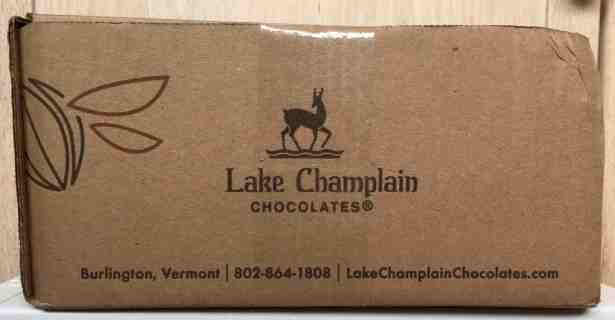
If all of my spices had come from the same brand—or if I purchased a set of matching bottles to standardize the lids (more on this notion coming up in the next section!)—this solution might even have been aesthetically pleasing enough for me to keep long term.
A plain box can always be covered in attractive paper, after all, and one can get crafty with some decoupage.
While an environmental win and very economical, the same solution was less effective for my non-standard sized flavorings. These were living in a repurposed paperboard shoe box, a little wider and a little shallower from shelf to open top.
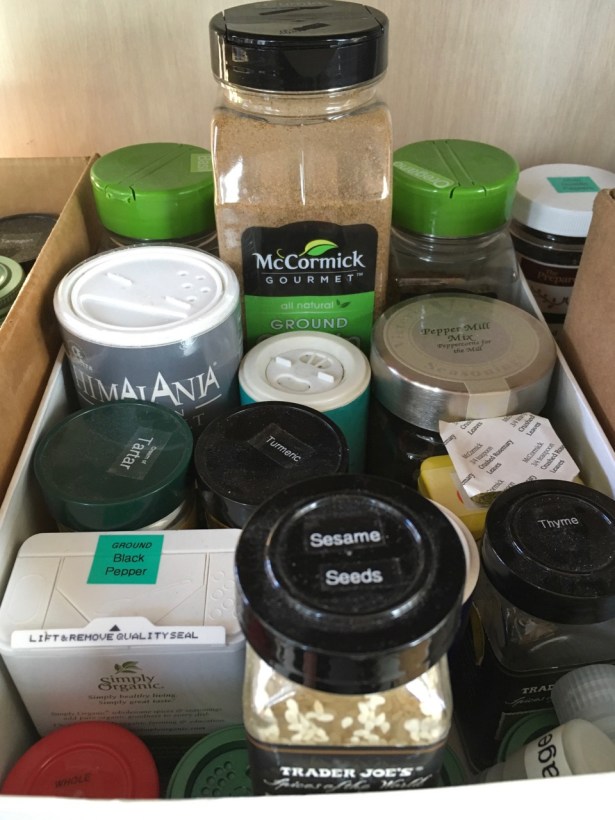 Aside from looking plain in mismatched paper, the opaque boxes made it very difficult to find any of the half-height, mini bottles that are a sensible grocery store choice for seasonings one uses rarely.
Aside from looking plain in mismatched paper, the opaque boxes made it very difficult to find any of the half-height, mini bottles that are a sensible grocery store choice for seasonings one uses rarely.
Spices only remain fresh for about two years, after all, so if one doesn’t go through a full half ounce of marjoram in that amount of time, the frugal cook should stick to smaller packets.
One issue I have with buying some large and some small spice bottles—never mind the little plastic envelopes!—is that I prefer to keep all of my seasonings in alphabetical order. As an inveterate bookworm since childhood, it’s simply the most intuitive system I have for quickly finding particular items in an array.
Attempting to merge alphabetical order with varied packaging sizes and shapes has led to at least one unnecessary purchase of a spice I didn’t actually lack.
The final problem I personally encountered with my cardboard box storage method was the total weight of one carton full of 18 jars—almost 7 pounds.
It’s hardly an herculean effort to lift it, but it can be a bit much for me because of my autoimmune arthritis. Sometimes, cooking a meal consumes all the physical energy I’ve got for a given afternoon. On a bad day, even sliding out and shifting through 18 bottles in one box was too taxing for my limited strength.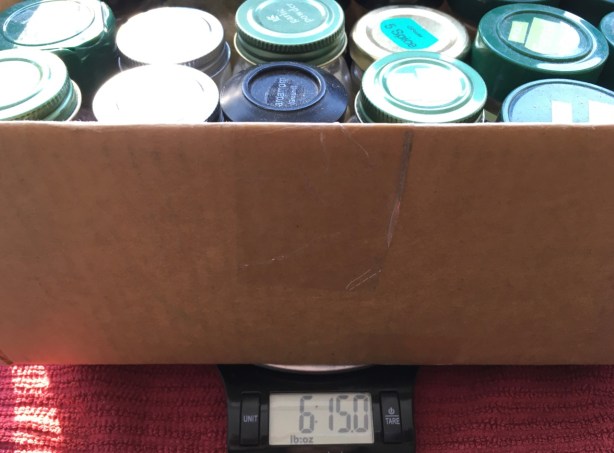
Fully able bodied chefs would probably find 12″ × 7″ × 5″ to be a very manageable size for handling spice jars. It was too heavy for me.
Then again, lightweight and maneuverable can save strain on anyone’s delicate joints, and also prevent repetitive use injuries. Many of us who have adapted to disabilities used to be perfectly healthy, too. Designing thoughtful, sensible storage options while young and fit makes aging in place easier later on.
Considering universal design at every stage of life—even in the bloom of life—is never a wasted effort, though I wish every reader as many years of robust good health as possible.
Standardize bottles for tidy storage, perfectly or close enough
I discovered that Amazon has listings for a brand of glass spice bottles that claims to be exactly the ones used by some of the major national brands: SpiceLuxe.
I had already surveyed the commercial spice jars I owned, recognizing my preference for the larger, squared off shape of Simply Organic brand packaging. Smaller, but with a similarly pleasing form, Whole Pantry and Trader Joe’s bottles tied for second place in my heart.
While not identical, I can happily intermix these two sizes within a bin to keep larger and smaller quantities in alphabetical order.
The larger jar is a 6 fluid ounce container which might hold over 4 dry ounces of seasoning salt; the smaller one is a 4 fluid ounce container which would hold closer to 3 oz of a similar salt.
Online reviewers frequently misunderstand the distinction between fluid ounces measuring volume and ounces as a fraction of pounds as a measurement of weight which Americans use for flour, sugar, etc. I strongly suggest reading the linked TheKitchn article before buying any containers if you don’t understand the difference lest you end up frustrated by what you get.
All of my supermarket glass bottles came with different colored lids, and each has an annoying raised ring embossed into the top of said lid.
I prefer to affix labels to the tops of my bottles to find them easily while protecting the glass from light inside a bin. The bumps on the supermarket lids therefore cause a practical hassle, not merely an aesthetic one.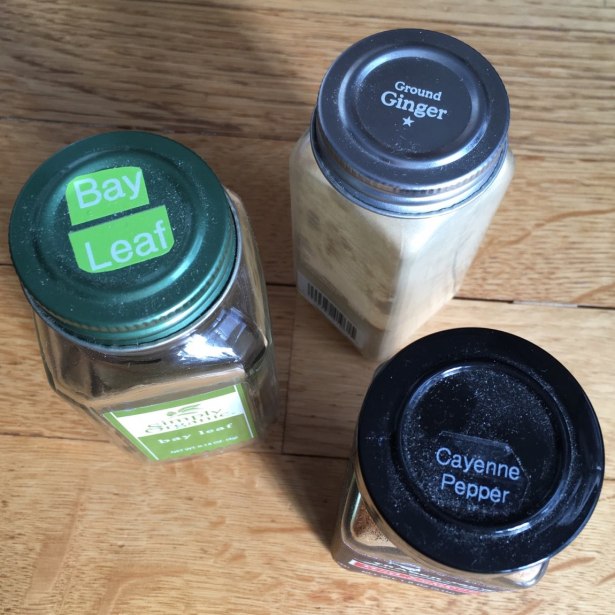
Fortunately, the sets of bottles offered on Amazon come with a choice of lids. They are marketed by color, but both the product listing photos and user review images show that most of the offerings have flat-topped lids. Sadly, my first choice for color, metallic green, was the only option that had those darn ridged rings.
To repackage all of my spices, I ordered one set of 12 large spice jars with white lids, two sets of small spice jars with white lids, and one package of 12 extra white lids.
The product listing for these aftermarket lids says, “Fits Glass Spice Bottles by SpiceLuxe ONLY,” but I now believe they are exactly the same as the supermarket brands I mentioned. I had no trouble replacing mismatched green metal, silver metal, or black plastic lids from store brand spice jars to new SpiceLuxe bottles, nor SpiceLuxe lids to most of my supermarket bottles.
Priced at $29.99 for a dozen with free Amazon Prime shipping, that works out to $2.50 per spice jar. The set of 12 lids alone was $9.99.
Alternatively, order direct from the SpiceLuxe site at the same or slightly lower prices, though I did not try this option to offer a review.
Every order of SpiceLuxe bottles includes a flexible funnel, a set of internal “shaker” lids sufficient to add one to every jar, and free labels listing the most common spices.
The funnel may be silicone; it was not separately packaged or labeled inside my shipping box, and, as a “free gift,” there were no details in the product description.
This funnel is useful for filling jars, but I prefer the metal one(s) I already had. There’s less static with a metal funnel than with the included flexible one.
Then again, I didn’t want to mix spices, potentially ruining a whole jar via cross contamination, so having more than one funnel meant I could fill a few bottles at a time between dishwasher runs. I would have been hand washing that funnel many times—then impatiently waiting for it to dry completely to avoid ruining powdery spices before re-use—if I hadn’t gotten the freebie funnel with each set.
Now that my spice jars have all been replaced, I will probably donate two of the three free, flexible funnels in my next batch of outgrown clothes and housewares sent to a local charity.
Personally, I pry off and toss away the internal sifting lids from all of my spices. Taking them off to stick a measuring spoon inside followed by replacing the inner lid annoys me too much. If I want to sift a spice, I pour a small amount into the jar’s lid then tap the product out to simulate sifting.
Or I use a mini strainer on those rare occasions that I really, truly require a sifted seasoning.
The final freebie—the sheets pre-printed labels with spice names—appears designed to adhere to the front or side of each jar, not to its lid according to SpiceLuxe’s own marketing photos. My only requirement for labeling was an aesthetically pleasing, round, legible one on each cap.
The 1 ¼″ label size might fit within the bounds of the smooth white caps I chose, but they would be too large for the ridged green lid option. You would need a 1″ round label to ensure it works on every possible SpiceLuxe cap or for commercial jars with ridged lids.
I discarded the pre-printed labels which were also repeated in each of the three sets. I didn’t care for the aesthetics of the large, italicized font or their silver color. I also didn’t want to hand write labels for which no pre-printed option was provided, and I prefer the specificity of adding the Latin botanical name to distinguish between, say, common Cassia and true Ceylon Cinnamon.
In order to create my own labels for the lids, I ordered Avery Waterproof 1″ Round Labels (36579) compatible with my laser printer. I used Avery’s web-based label creation software to create and print my labels as well.
Avery Template Presta 94500 worked out perfectly for the tops of both sizes of SpiceLuxe jars.
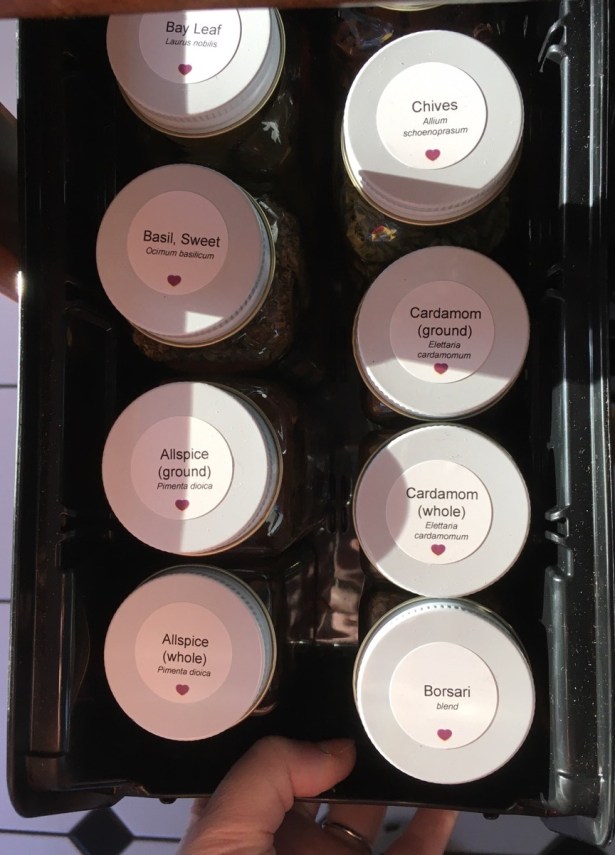
Here’s a PDF copy of my own Avery 94500 size Spice Jar Lid Labels for anyone who would prefer not to work with the template software.
Make sure to print at 100% size if you’re using my PDF or printing labels you design yourself!
I used my Brother P-Touch Model PT-1400 Label Maker and a black-on-clear TZ Tape cartridge to add best by dates to my new bottles. I didn’t bother to print an exact date for every bottle since spoilage is a lesser concern in this context than gradual degradation of flavor quality.
I batch printed the appropriate quantity of “Better before 202x” tags after sorting and counting the actual seasonings present on my spice shelf.
Bins shade bottles from damaging light
Having bottled my seasonings into a full set of similar containers, I turned to Akro-Mils AkroBins to protect those glass bottles from the sun streaming into my kitchen.
AkroBin 30230 turned out to be the perfect size for my shelf; each 30230 bin will hold two columns of four large or five small SpiceLuxe jars.
Here’s a photo of my finished project:
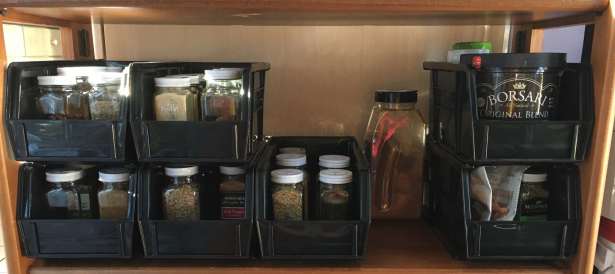
I purchased a set of 12 AkroBin 30230 from Amazon.com in February 2021 for $53.28.
That works out to only $4.44*** per bin. The manufacturer lists multiple retail and wholesale partners on its website if you prefer not to do business with Amazon. 
The lowest price I observed in early June 2021 for any color set of bins from the same source was $61.55 (or $5.13/bin), so it may pay to shop around or wait for a lower price before doing this organizational project.
It must be noted here that the AkroBin 30230 also makes a great organizational solution for an existing array of disparate grocery store spices in their original containers. I really wanted the visual simplicity of a field of similar white lids, but my kitchen would have looked better even if I had only replaced my mismatched paper and cardboard boxes with a set of these bins.
Compare for yourself from these two photos:
Rows and columns of identical—or even just similar—jars are much more appealing to my eye, though the slight variation in heights between the two sizes of SpiceLuxe jar is close enough to please me.
How many SpiceLuxe jars fit in one Akro-bin 30230?
Eight of the larger SpiceLuxe 6 fluid ounce jars will fit in two columns of four rows in an AkroBin 30230.

Up to five rows (10 total spice jars) can occupy the same if at least one bottle per column is the smaller 4 fluid ounce size. The jar at the front end won’t sit completely flush as you can see from the left-most column of the photo below. One jar will sit slightly raised up where the bin’s interior curves upward.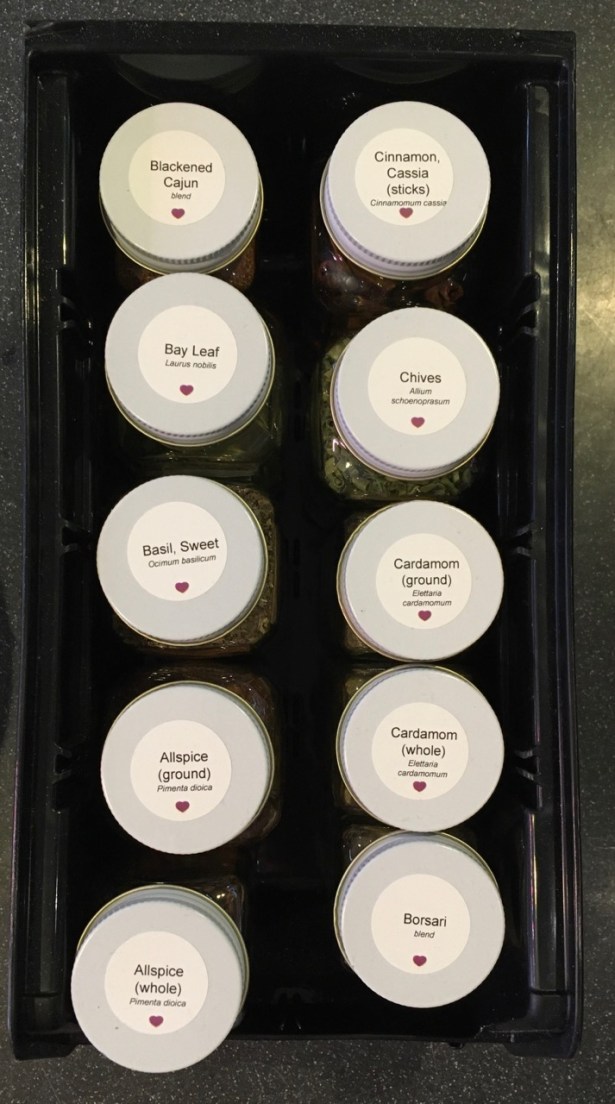
Three larger jars (6 fl oz) combined with two of the small (4 fl oz) ones is the maximum that fit per column without any wobbling or tipping in this bin. See the right-most column in the photo above.
Once you have created your own set of matching spice bottles, make the switch and refill them by purchasing in bulk or lightweight packets in the future. Shop at a local grocer with bulk bins, or buy online from Thrive Market or Penzey’s.
TL;DR Overview of better spice storage
Spice jars represent one of the few products where many major retailers offer already really excellent, sensible, space-conserving commercial packaging right off the grocer’s shelf. Buying only squared bottles by the same maker could give you a streamlined look in your kitchen with nothing else needed.
If you must buy rare seasonings in mismatched packages—or you already own a hodge-podge like I did—SpiceLuxe brand empty, square-shaped glass jars are available from Amazon. These will let you decant what you have into similar containers with a space-saving form factor.
The same brand, SpiceLuxe, sells sets of lids alone. I had good luck fitting them onto almost every brand’s spice jar that was already in my kitchen.
Use new lids to standardize the tops of your existing grocery store bottles. Simply adding top labels to new lids without disruptive ridges made it easier to find what I need without lifting every spice out of its home in a container on a shelf.
Finally, group your spices into space-efficient, light-blocking plastic bins by Akro-Mils if, like me, you want to protect what’s inside clear glass containers from damaging UV light coming through a nearby window. AkroBin style 30230 will fit from eight to ten spice jars per bin for most grocery store brands.
♦
‡ #10 (number ten) cans are quite large, sealed storage containers that resemble jumbo soup cans… the size of your head! Coffee cans are sometimes this size. Those who’ve worked in food service or gone to summer camp may have seen them in commercial kitchens. I believe that average people should keep at least a few weeks’ worth of shelf stable food on hand to guard against emergencies. When the pandemic hit, I was grateful to have freeze dried fruits, vegetables, and meats, plus dehydrated milk on hand so I didn’t have to visit local stores or vie for scarce delivery slots during the peak shortage of grocery items.
† Here’s a screen grab of the shopping cart that gave me those numbers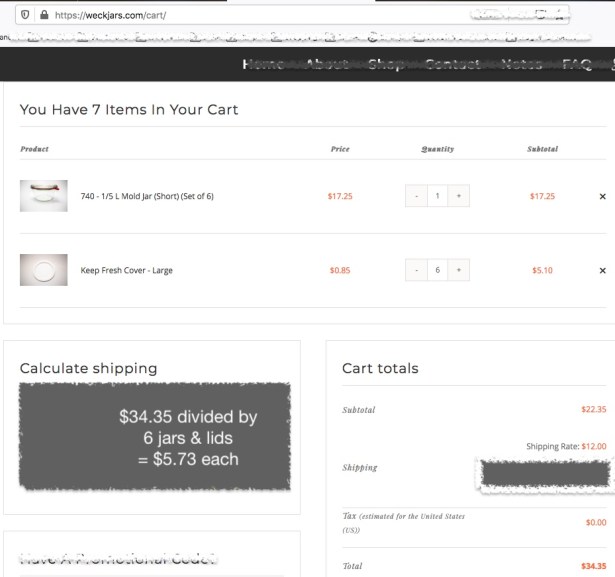
* Don’t assume that any of these lids are “air tight” the way a jar processed in a hot water canning bath would be. I can say from experience that the plastic and wood lids seal much more firmly on my Weck jars than the cork ones do. Consider the cork a mere “stopper,” readily lifted away with hardly any force. Since I think cork is meant to “breathe,” I don’t see this as a failing for this type of cover.
** Now defunct, my Bosch SHU66C dishwasher has been replaced by a modern Miele G 7316 SCU model. The Miele’s much narrower spacing between its baskets’ grids of bars has so far kept even small plastic items from reaching the bottom of its stainless steel tub.

 You’ll notice that my list has grown since I penned it in January. This is intentional. I take care to craft a set of goals that serve my long-term interests without undermining my short-term sense of accomplishment.
You’ll notice that my list has grown since I penned it in January. This is intentional. I take care to craft a set of goals that serve my long-term interests without undermining my short-term sense of accomplishment.




 If you’re anything like me, investing in a solar oven for summer cooking without heating up the kitchen leads you right to the need for an adapted chocolate cake recipe to suit it.
If you’re anything like me, investing in a solar oven for summer cooking without heating up the kitchen leads you right to the need for an adapted chocolate cake recipe to suit it.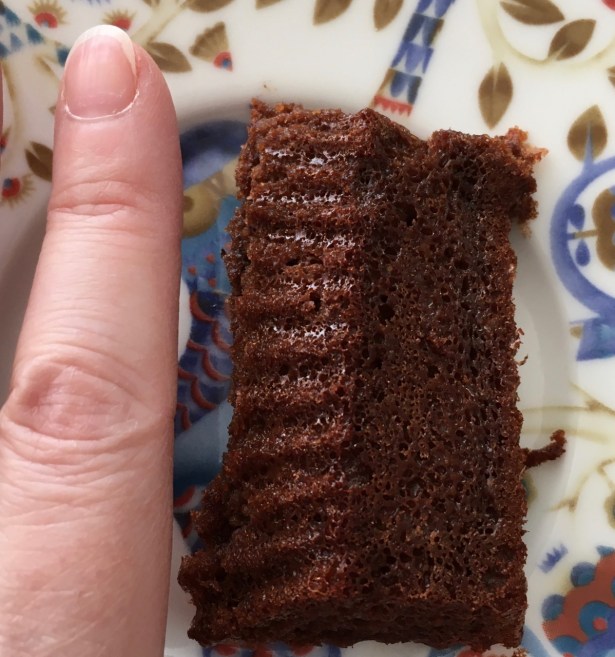







 Note that these are European canning jars, so the included lid will be a round of glass that merely sits in place until sealed via heat processing around its separate rubber ring (not ideal for your dry spices!) For that reason, you will also need to purchase a plastic (
Note that these are European canning jars, so the included lid will be a round of glass that merely sits in place until sealed via heat processing around its separate rubber ring (not ideal for your dry spices!) For that reason, you will also need to purchase a plastic (









 I use a little wire basket to gather what I need, carry it over to the island where I do prep work, and then return the spices en masse when I’m finished with them.
I use a little wire basket to gather what I need, carry it over to the island where I do prep work, and then return the spices en masse when I’m finished with them.


 Aside from looking plain in mismatched paper, the opaque boxes made it very difficult to find any of the half-height, mini bottles that are a sensible grocery store choice for seasonings one uses rarely.
Aside from looking plain in mismatched paper, the opaque boxes made it very difficult to find any of the half-height, mini bottles that are a sensible grocery store choice for seasonings one uses rarely.






















